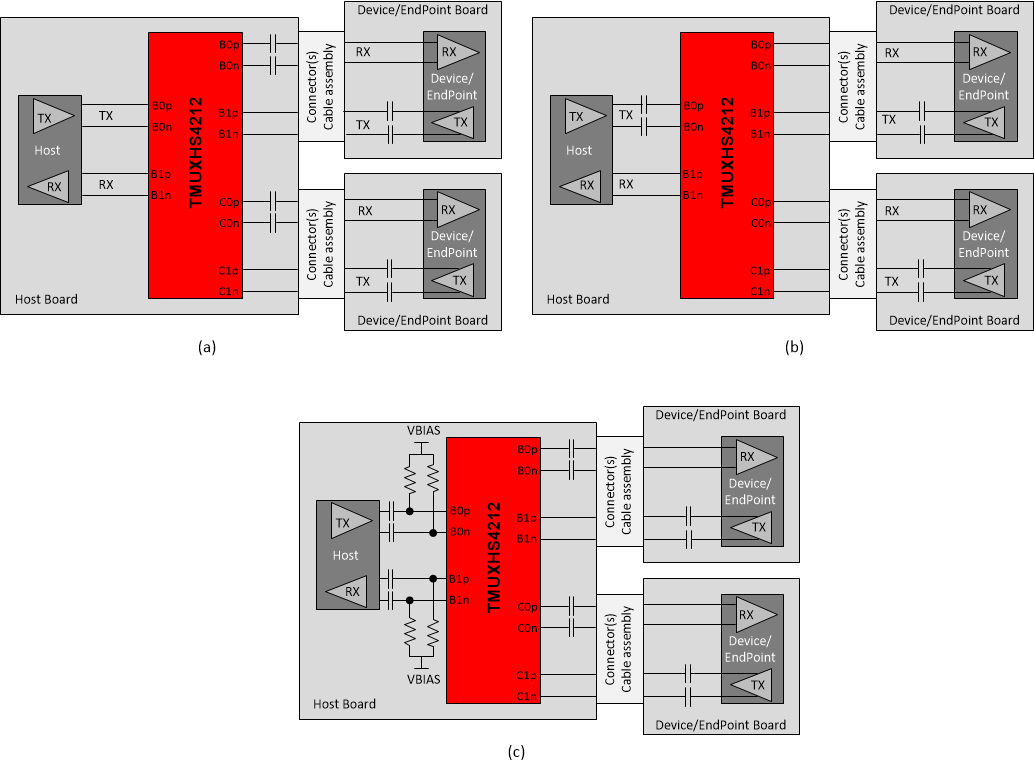SLASEP7A May 2020 – May 2022 TMUXHS4212
PRODUCTION DATA
- 1 Features
- 2 Applications
- 3 Description
- 4 Revision History
- 5 Pin Configuration and Functions
- 6 Specifications
- 7 Parameter Measurement Information
- 8 Detailed Description
- 9 Application and Implementation
- 10Power Supply Recommendations
- 11Layout
- 12Device and Documentation Support
- 13Mechanical, Packaging, and Orderable Information
Package Options
Mechanical Data (Package|Pins)
- RKS|20
Thermal pad, mechanical data (Package|Pins)
- RKS|20
Orderable Information
9.1 Application Information
The TMUXHS4212 is a generic 2-channel high-speed mux or demux type of switch that can be used for routing high-speed signals between two different locations on a circuit board. The TMUXHS4212 supports many high-speed data protocols, provided the signals' differential amplitude and common mode voltage are within <1800 mVpp and a common mode voltage is <1.8 V. The TMUXHS4212 can be used for many high speed interfaces including the following:
- Universal Serial Bus (USB) 3.2 Gen 1.0 and 2.0
- USB Type-C
- Peripheral Component Interconnect Express (PCIe™) Gen 1.0, 2.0, 3.0, and 4.0
- Serial ATA (SATA/eSATA)
- Serial Attached SCSI (SAS)
- DisplayPort (DP) 1.4 and 2.0
- Thunderbolt™ (TBT) 3.0
- Mipi Camera Serial Interface (CSI-2), Display Serial Interface (DSI)
- Low Voltage Differential Signalling (LVDS)
- Serdes Framer Interface (SFI)
- Ethernet Interfaces
The device’s mux or demux selection pin SEL can easily be controlled by an available GPIO pin of a controller or hard tie to voltage level H or L as an application requires.
The TMUXHS4212 with adaptive voltage tracking technology can support applications where the common mode is different between the RX and TX pair. The switch paths of the TMUXHS4212 have internal weak pull-down resistors of 1 MΩ on the A port pins. While these resistors bias the device data channels to common mode voltage (CMV) of 0 V with a weak strength, it is recommended that the device is biased from either side of the device to a valid value in the range of 0 – 1.8 V. It is expected that the system/host controller and Device/End point common mode bias impedances are much stronger (smaller) than the TMUXHS4212 internal pull-down resistors; therefore, they are not impacted.
Many interfaces require ac coupling between the transmitter and receiver. The 0201 or 0402 capacitors are the preferred option to provide ac coupling. Avoid the 0603 and 0805 size capacitors and C-packs. When placing ac coupling capacitors, symmetric placement is best. The capacitor value must be chosen according to the specific interface the device is being used. The value of the capacitor should match for the positive and negative signal pair. For many interfaces (such as, USB 3.2 and PCIe) the designer should place them along the TX pairs on the system board, which are usually routed on the top layer of the board. Depending upon the application and interface specifications, use the appropriate value for ac coupling capacitors.
The ac coupling capacitors have several placement options. Typical use cases warrant that the capacitors are placed on one side of the TMUXHS4212. In certain use cases, if both sides of the TMUXHS4212 are ac coupled, then it is recommended to use appropriate CMV biasing for the device. 10 kΩ to GND or any other bias voltage in the range of 0 – 1.8 V for each A[0/1][p/n] pin will suffice for most use cases. Figure 9-1 shows a few placement options. Some interfaces such as USB SS and PCIe recommends ac coupling capacitors on the TX signals before it goes to a connector. Option (a) features TX ac coupling capacitors on the connector side of the TMUXHS4212. Option (b) illustrates the capacitors on the host of the TMUXHS4212. Option (c) showcases where the TMUXHS4212 is ac coupled on both sides. Range for VBIAS is range of 0 – 1.8 V.
 Figure 9-1 AC
Coupling Capacitors Placement Options Between Host and Device/Endpoint Through
TMUXHS4212
Figure 9-1 AC
Coupling Capacitors Placement Options Between Host and Device/Endpoint Through
TMUXHS4212